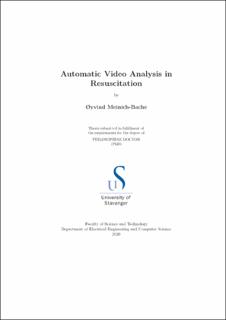| dc.contributor.advisor | Engan, Kjersti | |
| dc.contributor.advisor | Eftestøl, Trygve | |
| dc.contributor.advisor | Austvoll, Ivar | |
| dc.contributor.author | Meinich-Bache, Øyvind | |
| dc.date.accessioned | 2020-10-22T11:23:56Z | |
| dc.date.available | 2020-10-22T11:23:56Z | |
| dc.date.issued | 2020-01 | |
| dc.identifier.citation | Automatic Video Analysis in Resuscitation by Øyvind Meinich-Bache, Stavanger : University of Stavanger, 2020 (PhD thesis UiS, no. 499) | en_US |
| dc.identifier.isbn | 978-82-7644-900-6 | |
| dc.identifier.issn | 1890-1387 | |
| dc.identifier.uri | https://hdl.handle.net/11250/2684476 | |
| dc.description | PhD thesis in Information technology | en_US |
| dc.description.abstract | This thesis investigates possibilities for applying automatic video analysis in the medical context of resuscitation of a patient. Two situations are investigated: 1) Out-of-hospital cardiac arrest (OHCA) where there is a need for cardiopulmonary resuscitation (CPR) and 2) newborn resuscitation where the newborn is in need of various resuscitation activities, such as stimulation and ventilation support. Both situations suffer from high mortality rates and measurement of resuscitation parameters and activities to evaluate if the performed resuscitation complies with the recommended guidelines, could contribute to ensure provision of quality treatment. Currently there are no clinical solutions utilizing automatic video analysis to improve the quality of the resuscitation in the two situations approached in this thesis.
In this work, conventional image processing methods, such as segmentation and frequency analysis approaches have been used to perform measurementof the CPR quality during simulated OHCA situations. The methods for measurement of chest compression rate and CPR summary parameters are implemented in a smartphone app which performs real-time measurements and communicate the information to a webserver that could be monitored by the emergency unit. The system performance is satisfactory with accurate measurements and could add valuable information to the communication between the caller and the emergency unit in OHCA situations.
Deep learning and convolutional neural network (CNN) approaches have been used for activity recognition from newborn resuscitation videos. The proposed system, ORAA-net, is a two-step approach consisting of 1) Object detection and Region proposal using a 2D CNN and post-processing, and 2) Activity recognition and generation of Activity timelines using 3D CNNs. The system provides promising results on a dataset of noisy low quality newborn resuscitation videos. By detecting and quantifying the amount of the relevant activities for each episode, a better understanding of the effect of the different resuscitation activities can be achieved, and potentially contribute to optimize patient treatment in newborn resuscitations situations. | en_US |
| dc.language.iso | eng | en_US |
| dc.publisher | University of Stavanger, Norway | en_US |
| dc.relation.ispartofseries | PhD thesis UiS; | |
| dc.relation.ispartofseries | ;499 | |
| dc.rights | Copyright the author, all right reserved | |
| dc.subject | automatisk videoanalyse | en_US |
| dc.subject | gjenoppliving | en_US |
| dc.subject | hjerteinfarkt | en_US |
| dc.subject | bildebehandling | en_US |
| dc.subject | informasjonsteknologi | en_US |
| dc.subject | medisinsk teknologi | en_US |
| dc.title | Automatic Video Analysis in Resuscitation | en_US |
| dc.type | Doctoral thesis | en_US |
| dc.rights.holder | © Øyvind Meinich-Bache, 2020 | en_US |
| dc.subject.nsi | VDP::Mathematics and natural science: 400::Information and communication science: 420 | en_US |
| dc.subject.nsi | VDP::Teknologi: 500::Medisinsk teknologi: 620 | en_US |
